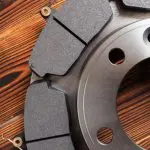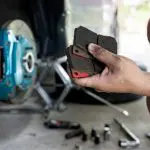The brake is perhaps the most delicate part of the car as it is needed to be in good condition always to guarantee the safety of everyone in the car.
The components of the brake have to be checked regularly to ensure this and this includes the disc brake system.
The brake pads are one component that makes up the disc brake system and thus should be checked regularly so that it is not worn out to the extent that it might cause damage to the other parts as well as lead to dangerous driving.
Do you know how to check your brake pads? Brake pads can be checked by going below the car and visually examining the brake pads by yourself.
You will be able to see the thickness of the brake pads. You can check the brake pads using the following procedure:
- Remove the car front wheel using a car jack and a wrench. This is because the brake pads are accessible when you take off the wheels. That is where you find the disc brake system.
- Locate the disc brake system. You should be able to see this when you have taken off the wheel from the axle.
- Use the tape measure and compass to measure the brake pads in millimeters.
You will be able to sport the brake pads on the part between the brake rotors and calipers. You can then measure their thickness using a compass and a tape measure.
The front brake pads wear out faster than the back brake pads because most cars are designed to apply their braking from the front. As such you will realize the need to replace them more often.
Similarly, other factors such as the driver’s driving habits as well as the condition they drive in mostly affect the degree of wear and tear subjected to the brake pads.
This video also helps you understand better:
TABLE OF CONTENTS
How To Check Brake Pads While Driving
You do not have to get out of the car to check the condition of the brake pads. There are ways you can do this even as you are driving.
You can check on the condition of your brake pads while you are driving through the following ways:
- Keeping a keen ear to the brakes: Brake pads that are worn out will produce a noise that should signal a warning of the need for replacement. This might either be through squealing which is caused by a metallic indicator.
- The reaction of the brake pedal and car steering wheel: When you apply the brakes and you notice the brake pads reacting abnormally, then your brake pads or rotors might be in poor condition.
The pedals might appear to be vibrating in a manner that is not usual for them. Similarly, poor brake pads might cause the car steering wheel to vibrate. - The warning light comes on: When the indicator light comes on the dashboard even when you have not switched them on, then the brake pads might cause this. This is because some cars have advanced technology that will cause the indicator lights to go on when the brake pads are worn out.
The above signs show that the brake pads are in poor condition. You should not be alarmed, however, when you hear squealing when you apply brakes during a rainy season.
This might not be because of the brake pads. If the noise persists, check for other signs or call an expert to examine their condition.
When Should You Check Your Brake Pads?
The brake pads should be checked regularly to ensure the safety of those in your car.
This is because you might never know when they get worn out even as you are keen on the distance covered.
The thing is even as most of the brake pads are designed to last for as long as 50,000miles. Several other factors will come into play in determining whether they are worn out or not.
Checking the brake pads can be done simply by just going underneath the car and checking on them.
Alternatively, you can have a professional or a mechanic do the checking for you and they will do a great job as they are highly experienced.
They will also have a look of other components of the braking system and tell you if they are in good or bad condition. This will help guarantee the safety of the car at all times.
4 Signs Can Tell If Your Brake Pads Are Bad
There are 4 signs that will show that your brake pads are deteriorated and will need to be replaced soon.
These include when you hear squealing and screeching noises when you use your brakes.
- This usually occurs from a metallic shim that is embedded at some level of the brake pads and it indicates the wearing out of brake pads beyond a certain level.
- When you hear a deep metallic grinding and growling sound, then that is a sign of the disc brake being in poor condition.
This shows that the brake pads are almost completely worn out and that the brake calipers and rotors are in contact with one another and the friction is not good for the two metallic parts.
Therefore, you should get the brake pads replaced and the brake rotors will also have to be looked at as they might also be in a very bad condition. - You can also get this done the simple way by just going underneath the car and checking out the condition of the brake pads.
This should be seen between the tire spokes; the brake pads are seen to be pressed against a metallic disc like part.
When you notice that they are less than 3 mm in thickness, then it is time to have them replaced. - Some models of cars are advanced in technology such that when the brake pads are in poor condition, the indicator lights will tell of this condition.
The light might be seen to come on even if you do not switch them on by yourself on the dashboard.
Also, this article on when to replace brake pads can help you.
Where Are The Brake Pads Located?
The brake pads are located on the axle of the car on what is called the disc brake system.
This component, the disc brake system, can be seen when you take off the wheel from the axle of the car; either the front or back wheel.
It can be seen to be positioned or rather attached to the part that is connected to the tires.
The disc brake system is comprised of three parts; the brake rotors, the brake calipers, and the brake pads.
The rotor is seen as the large metal disc that varies in design from one car to the other, the calipers are attached on the rotor in such a manner that they are seen to have a firm grip on them.
The brake pads separate these two, the brake rotors and the calipers, and appear as either rubber, steel or even ceramic.
They are positioned in a way that they receive the force from the calipers and transfer it to the rotors in a manner that the friction is distributed to avoid wearing out of the rotors unevenly.
As such the brake pads are bound to experience wear and tear and thus have to be replaced quite often that the other parts.
Otherwise, they might be too worn out to get their job done and thus more damage is caused on the other components of the disc brake system.
How Thick Should Your Brake Pads Be?
When you are buying a new set of brake pads they should not be less than 12 mm in thickness. This will be enough to be used for a distance of 50,000 miles before being replaced.
The minimum size recommended for a set of brake pads should be 3mm to 4 mm. This should be the thinnest size that any brand of brake pads.
Below this point, the brake pads will not be in a capacity to get their job done and thus damage will be passed to the rotors. The brake pads will also experience cracking which is not a good sign.
Different manufacturers propose different minimum thickness and this depends on the performance of their products.
You can also notice that different performance will be seen from brake pads that are manufactured from different materials.
Can You Change Your Brake Pads By Yourself?
Yes, changing the brake pads is just like changing a punctured car wheel.
This will be simple if you have all the required tools such as a good jack to raise the car, next you will have to take off the car wheel and you will be able to access the disc brake system.
From there the brake pads are easily reached and you can even check the condition of the other parts of the car braking system.
Changing the brake pads is not a difficult task, and if you are not afraid of getting dirty or having grease and oil on your skin, you can go for it.
This solution is also quite inexpensive and you can get it done in less than one hour.
Calling a technician will not only be costly but will be time-consuming as they might get there late.
Alternatively, you might also not be able to drive your car to the auto repair shop due to it being in a very poor condition.
Getting it done by yourself also gives you the opportunity of understanding your car better.
For more information, you can check this article on how to change brake pads.
Conclusion
When it comes to the safety of your car, one thing you will have to do is to be keen on the condition of the brake pads.
This is because the brake pads wear out with time and eventually are too thin and thus unable to work well in the car. This can be noticed even as you drive your car and try to apply the brakes.
Changing the brake pads early before they wreak havoc is important to avoid further damage to other parts of the car, especially the disc brake system.
For instance, when the brake pads are too thin, they are unable to reduce friction on the rotors and thus the rotors are adversely affected.
This may not only turn out to be dangerous to you as the car driver, but it will pile repair expenses as the rotors too will have to be replaced.
Sources:
1. Wagner Brake – https://www.wagnerbrake.com/parts-matter/automotive-repair-and-maintenance/how-to-check-brake-pads.html
2. Allstate – https://www.allstate.com/blog/check-cars-brake-pads/




